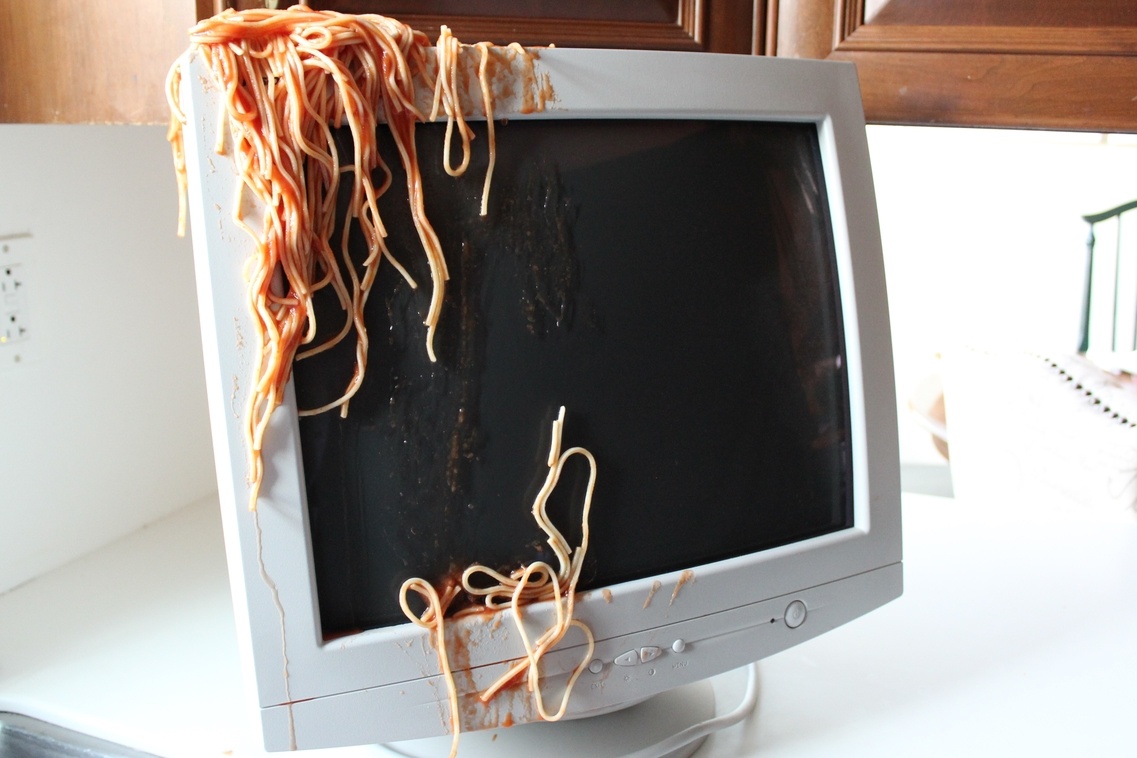
The physical environments inside food service establishments are unique and prove to be far more harsh to IT equipment & systems than those in almost every other industry. If you haven't experienced bacon grease spatter as the cause of a router failure, or witnessed a deep fryer turn a brand-new digital order display into an unreadable, unusable light blob in just a few weeks, then you probably can’t appreciate the unique challenges facing Restaurant IT Managers.
Thanks to input from several customers who happen to live in that role, I’m happy to present Three Pain Points that only IT Leaders of Restaurant Chains Can Understand.
GREASE - and we aren't talking about the musical
There are countless appliances used inside restaurants that wreak havoc on IT equipment. Not just ovens and stove tops, but the dishwashing machines, heat lamps, and especially deep fryers.
“Grease is a mist that covers everything” says Rick Reno, Director of IT for The Johnny Rockets Group restaurant chain. “We recently had a new digital display mounted over our fryers in one restaurant, and it failed after just 60-days.”
Ashton Holton, the Tier 3 Helpdesk Manager with Carlisle Corporation (a leading franchisee company for Wendy’s and LYFE Kitchen restaurants), agrees and says their rule of thumb is simply, "if a device requires the use of a fan, then it’s probably going to fail.”
So the next time you fret over a slight increase in temperature inside your climate-controlled, static-free data center, imagine how much bigger your problems would be if your servers were surrounded by pizza ovens, grill tops, and deep fryers.
DAMN THIS TRAFFIC JAM
Once upon a time, IT Managers in every industry only handled their company’s data networks, switches and computers. The PBX, desktop phones, and fax machines ran on a separate cabling infrastructure, and were the responsibility of the Telecommunications Department.
Can You Hear Me Now?
But when VoIP technology was introduced – making it possible to run voice traffic over data networks -- most companies eliminated their Voice Networks and the Telecom Departments that managed them, and gave the IT Department responsibility of both Data & Voice.
The same thing happened when antiquated, analog CCTV (closed circuit television) security systems running on coax cabling were replaced by new, digital video-over-IP surveillance systems. While they didn’t eliminate their Security Departments altogether, most Restaurants did shift the responsibility of deploying & maintaining these new video systems to their IT Departments, simply because they operated over IP.
Add a Side of WiFi, Please...
Just as the IT leaders of Restaurants got used to dealing with the bandwidth demands of all their wired internal systems, smart phones took over the world and forced them to deal with wireless networks too. As mobile devices became a prevailing technology for business and personal use, Restaurants learned that the availability of Free WiFi was becoming a key decision-making criteria for consumers when choosing a place to eat. Suddenly Restaurant IT Managers were tasked with deploying wireless networks in all their restaurants, and configuring not only guest WiFi networks but separate employee wireless networks too.
And Can You Biggie Sign it?
Most recently, the Federal Government indirectly influenced nearly every Restaurant chain to take serious looks at Digital Signage. The Common Sense Nutrition Disclosure Act of 2015 required that, by December 31, 2016, every restaurant & food service chain consisting of more than 20 locations must show Calories on their menus. (The State of California took this a step further by also requiring Sodium content on menus.)
When faced with the knowledge that they must either bear the expense of replacing all of the printed and/or manufactured menu signs in their restaurants immediately – knowing they may have to do it again if more requirements were imposed by the Government in the future – OR make a much larger initial investment in digital menu boards (to replace their static menu signs) so that all future changes could be made quickly, easily, and without a substantial capital investment, many restaurants chose to deploy digital menu boards.
When you consider the impact of all of these systems when they are connected to the same network – each struggling to communicate effectively over their tiny allotted chunk of bandwidth on the same network -- it’s more than just a miracle that certain Restaurant systems don’t fail more often; It’s a testament to the unique talents and technical finesse possessed by every successful Restaurant IT Manager.
THE BEST LAID PLANs
There are many things that Restaurant IT Managers just don’t think about when mapping out a Technology Plan, including Emergency Backup Plans. One often overlooked item is rogue devices. The Restaurant industry employs a much higher percentage of young people (meaning high school & college age) than almost every other industry. And young people don’t go anywhere without their mobile devices.
Several Restaurant IT leaders told me that they’ve had countless instances where a restaurant system has stopped working – in one case, a credit card reader that connected to the Cash Register Computer via USB. Upon investigating the issue, an IT Director learned that an employee unplugged the credit card reader so they could plug their cell phone into the computer’s USB port in the hopes of charging their phone battery.
A different Restaurant IT Manager – who also asked to remain anonymous – said their IT Help Desk received an emergency call from one of their Restaurants on a busy Friday night because their Wireless Network was down. Just a few months earlier, they had rolled out WiFi in their restaurants to enable their wait staff to take orders using tablet computers – which immediately transmitted those orders to the kitchen. Since they had disposed of the old paper order tablets, the entire restaurant was in chaos. After diligently working with the on-site Manager to perform some basic troubleshooting triage, they learned that one of their Dishwashers who was taking his break in the employee break-room had disconnected the cable from the Restaurant’s router so he could plug it into his laptop and check his Facebook page.
Lightning Never Strikes Twice...
In addition to random rogue devices causing headaches for Restaurant IT Leaders, the unpredictable havoc that Mother Nature can reign can be very frustrating. Ashton Holton of Carlisle Corporation told me “lightning is one condition you can never plan for precisely because it’s so unpredictable, and you can never know the extent of damage to your systems and devices until after it strikes.”
Ashton cited this example: “We had a single Wendy’s Restaurant location we own get struck by lightning not just once, but three times on three consecutive days.” While they had hot-swappable backup UPS units available to replace those that were fried in the first lightning strike, they didn’t have enough readily available to replace those destroyed by the second strike…let alone those damaged after the third strike on the third day.
Regardless of which industry they work in, IT Leaders around the globe share similar challenges and headaches as they continuously strive to accommodate ever-evolving technologies. But until you've experienced a complete systems outage caused by a spilled plate of spaghetti, you don't know the unique trials and tribulations facing IT leaders in the restaurant business.
(Got a story of your own to share? We'd love to hear it. Email Tim Sauer at tim.sauer@techservicetoday.com)
If a lightning strike (or spilled plate of spaghetti) take your systems down, Tech Service Today can deliver a Technician on-site anywhere in North America in 4-hours or less.
Just call (800) 973-2022 (option 1), or Email us at Service@TechServiceToday.com
